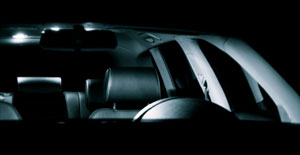Interior Lighting Control
- Basic Description
-

Years ago, the interior lighting in cars consisted of a few incandescent lights that turned on or off in response to microswitches in various doors or simple switches near the light fixture. Today's cars may have more than a dozen interior lights (mostly LEDs) whose function and brightness are computer controlled. Interior lights are typically located in the ceiling (the dome light), the doors, the console, the dash, the trunk, above or between the visors, and various other places within the vehicle. These lights provide illumination for the driver and passengers to enter and exit the vehicle; they illuminate certain control surfaces; and they add style and warmth to vehicle interiors. The electronic control unit that activates the lights, uses information from door lock position sensors, various door position sensors, the ignition switch, ambient light sensors and occupant-adjustable switches and potentiometers to determine the appropriate illumination levels for each light. Interior lighting levels may be controlled by a vehicle's body control module; or the control of various lights may be handled by different processors distributed throughout the vehicle.

Lighting control modules control the brightness of individual lights using pulse-width modulated (PWM) signals that typically turn the light on and off at a frequency of about 200 Hz. Once the lights are activated, they may remain powered on for a certain amount of time and then dim until powered off.
LEDs (light emitting diodes) have largely replaced incandescent lights for interior lighting applications due to their higher efficiency and longer life.
Some recent interior lighting innovations include systems that adjust the color and brightness of various lights in response to the ambient temperature (for a warmer or cooler feeling) and systems that replace traditional manually operated switches with motion and/or proximity sensors.
Interior lighting systems are also beginning to be used to convey information to the driver. The 2014 MINI Cooper has an LED ring around a display in the center stack that is connected to several different systems. The ring can change colors depending on which driving mode the car is in or depending on input from engine speed sensors, audio volume settings, climate control settings, and personalized interior lighting moods.
- Sensors
- Switches in dash and doors, potentiometers, ambient light sensors, motion sensors, proximity sensors, temperature sensors
- Actuators
- Lights
- Data Communications
- Control Unit Communication: Typically CAN or LIN
- Manufacturers
- CML, Delphi, Grakon, Hella, Johnson Controls, Optis
- For More Information
- [1] Automotive Lighting, Wikipedia.
- [2]
Spotlight on Automotive Interior Lighting, Peter Murphy, Machine Design, Feb. 21, 2001.
- [3] Interior Blue LED Lighting in Motion, YouTube, July 2008.
- [4] Ambient Lighting Makes Drivers Feel Safer, Chuck Squatriglia, Wired, Aug. 18, 2010.
- [5] LEDGlow's 4 Piece LED Interior Lighting Kit Installation Video, YouTube, June 15, 2012.
- [6] LEDs Lend Ambience to Automotive Interior Lighting, Digi-Key, Sep. 18, 2012.
- [7] Innovative Interior Lightning Creates Style and Ambience that Car Buyers Love, Melih Tuzmen, W-Info-Autos, Apr. 15, 2013.
- [8] Interior Lightning Takes Lead Role, James Amend, WardsAuto, May 22, 2013.
- [9] Adding a Personal Touch to Automotive Interior Lighting via LIN, Michael Bender, ECN, Sep. 10, 2013.
|

